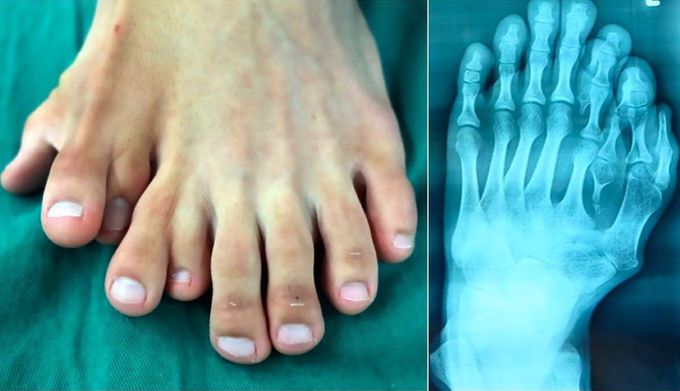


Young man born with NINE toes on one foot! 👣
This is a condition called polydactyly — supernumerary (or accessory) fingers and/or toes! The 21-year-old man born with nine toes on his left foot had the four extra digits surgically removed after a lifetime of living with the deformity. The patient said the 4 extra toes on his left foot had caused him so much stigma he stopped wearing sandals when he was 10 and been too embarrassed to go on a date. The X-ray shows smaller digits sprouting out of normal-sized toes, and a lack of a big toe. His parents were aware of his condition as soon as he was born, but they refused to let doctors operate on him. They sought the advice of a fortune teller instead, believing that his extra toes were ‘a gift from the heavens’ which shouldn’t be removed. Seeking a reversal of fortune, he sought out expert advice. It’s very rare to see such a serious deformity having not been treated in a 21-year-old patient. Removing his outermost extra toes would’ve been the easiest solution, but it wouldn’t look the best. His most natural looking toe is on the outside, so doctors decided to migrate it inwards to its most ideal position, replacing his fifth digit and creating a new big toe. The surgical team spent 9 hours in surgery to create the patient's new left foot. Polydactyly is classified as either preaxial (duplication medial to the first toe), central (duplication around the second to the fourth toes), or postaxial (duplication lateral to the fifth toe), the latter of which is the most common. The toe may be rudimentary (without osseous structures) or a complete digit with its own metatarsal. This patient had complete central and postaxial duplications. Because protruding toes can cause problems with the fit of footwear in the future, the decision to remove them usually is made before the child begins to walk. The ideal age at which to remove supernumerary toes is between 9 and 12 months. At this age, the foot is large enough to make excision simple, and the child is less aware of the problem. Simple resection of the extra toes is generally sufficient, especially in cases of postaxial deformity.
All 9 toes are remarkably well formed including toe nails!
Hemodynamic stimuli&nonhemodynamic stimuliEffects of sugar on teeth


